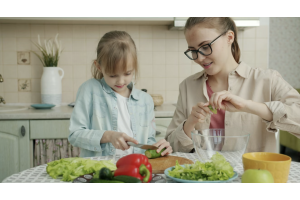How To Get Kids To Eat Green Veggies

Getting a child to eat vegetables can be challenging for many parents. While some are open to embracing vegetables and new foods, others might require more exposure or specific preparations.
Vegetables don't only provide nutrients for growth and development, but their early introduction can also encourage your children to eat various foods in the future. If you're one of those parents who can't get their child to eat green veggies, below are some tips to help you.
Why Is It Important for Children To Eat Vegetables?
Your kids get energy, vitamins, antioxidants, fiber, and water from vegetables. They help prevent your child from developing chronic illnesses later in life, such as heart disease, stroke, and other types of cancer. Also, eating a lot of the best greens for kids and a wide variety of meals from the other major food groups constitutes a healthy diet.
According to the Australian Dietary Guidelines, children aged 1-2 years must have 2-3 servings of vegetables daily, while 2-3 years must have 2½ serves, and 4-8 years must have 4½ serves. It's crucial to support your child even if they struggle to consume enough vegetables. Your child will establish healthy eating practices for life if you assist them in doing so now.
6 Ways To Get Your Kids To Eat Green Veggies
Continue to expose them to vegetables
It's simple to become disappointed if your child rejects a vegetable, especially if you've tried multiple times to convince them to eat it. But if you repeatedly present them with the same vegetable, there's a decent chance they'll give it a try eventually.
Don't forget to consider quantity proportions and cooking methods when introducing your toddler to a new veggie or one they haven't previously liked. To avoid turning them off or overwhelming them with a full meal, start with a modest piece, like one or two nibbles.
Repeated exposure might encourage your children to eat vegetables. If your child initially rejects it, try again with the same or a different preparation.
Get them involved in the preparation and shopping
Take time to spend a day with your children in the produce area of the grocery store; so they become accustomed to eating vegetables. Or even if you choose not to take your children to the supermarket with you, still have them pick fruits and veggies from a catalog before you go or ask them to help you unpack goods when you come home.
Also, have your children involved in the preparation of the vegetables. For example, have the older children help with grating and chopping veggies while the younger ones assist with washing and tossing salad leaves. Doing this may increase their comfort level when it comes to eating vegetables.
Use fun shapes and brightly colored serving dishes
A child's willingness to consume vegetables can sometimes be because of factors other than the vegetable itself. Try cutting the vegetables into stars, hearts, or various shapes if your toddler rejects them when they are sliced or diced. You can do this with a knife or, for ease, with fruit and vegetable cutters.
Serve veggies on colorful plates or bowls while providing them with a meal. Forks and spoons are also available in various entertaining designs, including dinosaurs, building materials, and animals.
Vegetables can also be entertaining, especially for smaller kids. You can create a vegetable face for a snack plate using strips of capsicum for the lips, cherry tomatoes for the eyes, beans for the nose, and grated carrots for the hair.
The more variety there is, the more likely your children will find a vegetable they're interested in eating.
Make vegetables as snacks
Vegetables make a great snack. Your child will be more likely to choose veggies when hungry if you stock up on vegetables for snacks and minimize unhealthy snacks in your home. You can keep a container of chopped vegetables like cucumber or carrots in the fridge or serve them on a stick and have them dip the veggies in yogurt.
Furthermore, vegetables are also best served when incorporated with other food. Mix them in waffles or pancake batter, and top it off with maple syrup. Another approach to increase your toddler's consumption of vegetables is to mix shredded zucchini or riced cauliflower into oatmeal. You never know, they may even enjoy a vegan diet after this.
Choose packaged vegetables wisely
The idea that packaged foods are veggie-loaded is common. Many parents opt for these strategies when encouraging their children to eat greens. But avoid making these foods the only vegetables you serve, even though some of them are fine to include in a diverse diet that involves a variety of veggie preparations.
Your toddler may come to favor them, making it more challenging to serve any fresh or homemade alternatives. Additionally, some of these items are inappropriate for toddlers.
To be sure that the claims about the health benefits and vegetable content are accurate, it's also crucial to examine the ingredient list and nutrition label. Packaged veggies with veggie flour included in the ingredients are low in sodium and added sugar.
Show praise and appreciation when your child eats vegetables
Your child will be more inclined to eat veggies again if you compliment them each time they try or consume one. For praise to be effective, it should be specific. But try to keep the compliments from dominating the dinner. It is not your goal to praise or reward your child for eating veggies. But, you want to encourage them because they enjoy eating greens.
If you punish your child for not eating veggies, they may associate vegetables with bad things. Try not to make a big deal of your child's refusal to eat their vegetables; instead, try another time.
Bottom Line
Getting your children to eat vegetables is hard, but it is not impossible. Even if your child refuses to try greens, don't be discouraged from serving them again until they become used to it. Sure, it may take some time, and there will be bumps in the road, but it will be worth it once you see results.






